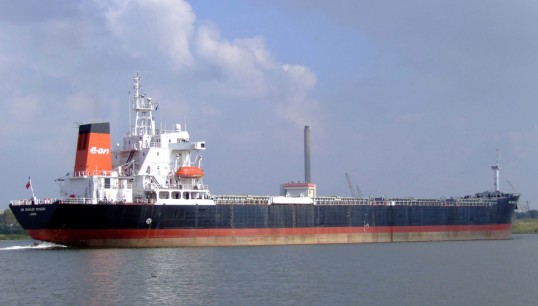Sir Charles Parsons

British coal trade
The UK coal trade was, for several centuries, a major employer of British seafarers who were highly valued for their standards of seamanship.
With power supplies nationalised after the Second World War, the Central Electricity Authority – which became the Central Electricity Generating Board (CEGB) in 1958 – took over the responsibility for a fleet of ships supplying coal to power stations.
The build
In the early 1980s, the CEGB decided to build a series of 22,000dwt 'super-colliers' as part of an 'economies of scale' plan to phase out older and smaller tonnage. The first of these ships was Sir Charles Parsons, named after the inventor of the steam turbine, and it was followed by sisterships Lord Citrine and Lord Hinton.
Built by Govan Shipbuilders and launched in May 1985, Sir Charles Parsons was of 22,530dwt and 154.85m (508ft) loa. Powered by an eight-cylinder Mirrlees KMR8MK3 type engine, geared to a controllable pitch propeller, the vessel had a service speed of 12.5 knots.
Deployments
The ship's main role was to carry coal from the Tyne Tees Coal Terminal to Kingsnorth power station on the River Medway in Kent, as well as imported coals trans-shipped via Dutch and Belgian ports.
Ownership
The CEGB colliers were originally under the management of the Newcastle company Stephenson Clarke, but from 1968 onwards Edinburgh-based Christian Salvesen (Shipping) took an increasing share of the fleet, and it was given responsibility for Sir Charles Parsons was taken on by Powergen and its management moved between Jebsen and Lothian Ship Management over the next decade.
Nuclear and oil-powered stations increasingly replaced the traditional coal-fuelled facilities from the 1960s onwards and the collier fleet was accordingly cut back. By 1999 only Sir Charles Parsons and Lord Hinton remained in service. Their ownership passed to E.On UK in 2004, and they were switched to Meridian Marine Management of Liverpool.
In August 2010, Sir Charles Parsons was sold to the Turkish shipping company Barko Denizcilik Tasimacilik, renamed Barko and put under the Cook Islands flag. In 2015, the ship was sold again and renamed Princess Ayat, spending the next three years trading between the eastern Mediterranean and the Black Sea under the Sierra Leone flag.
In 2018, the ship was sold to a Liberian-registered company and renamed Daytona Prime. It spent the next two years on a regular run between Istanbul and the north coast of Turkey before demolition at Gadani Beach, Pakistan, in October 2020.
Sir Charles Parsons fact file
What size was the vessel Sir Charles Parsons?
Sir Charles Parsons was 22,530dwt and 154.85m (508ft) loa
What year was the vessel Sir Charles Parsons launched?
Sir Charles Parsons was launched in 1985
When was the vessel Sir Charles Parsons demolished?
Sir Charles Parsons was demolished at Gadani Beach, Pakistan, in 2020
Contribute
Are you knowledgeable about this vessel?
Submit your contribution to this article to our editorial team.
Write to usView more ships of the past
HMS Beagle
Launched 200 years ago, HMS Beagle has been described as one of the most important ships in history – thanks to the observations on evolution and natural selection that its famous passenger Charles Darwin made during a five-year voyage around the world between 1831 and 1836.
Common.ReadMoreHMS Beagle
Manchester Challenge
Launched in June 1968, Manchester Challenge was one of the first British-built and operated cellular containerships, and it entered service in November that same year.
Common.ReadMoreManchester Challenge
Esso Ulidia
Delivered in October 1970, Esso Ulidia was one of eight 250,000dw-plus ships, which were all named after old British and Irish kingdoms, to be constructed for Esso's red ensign fleet between 1969 and 1973.
Common.ReadMore